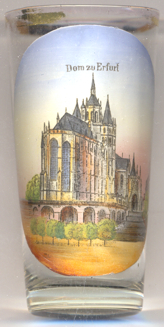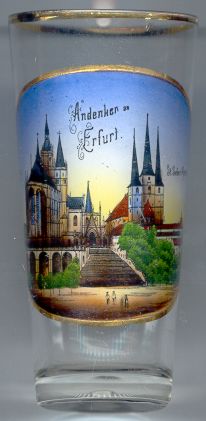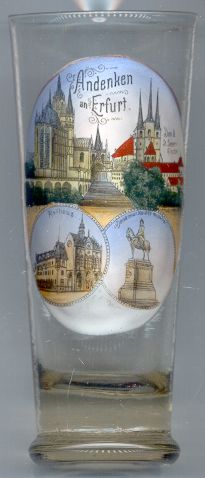

|
| DEUTSCHLAND | GERMANY |
| Bundesland: Freistaat Thüringen | Thuringia |
| Stadt: Erfurt |
Erfurt is situated at an elevation of 194 m river Gera furcates into the Wilde Gera and the Schmale Gera.
The place was first mentioned in AD 742 in a letter of St. Boniface asking Pope Zacharias for ratification for the
foundation of the bishoprics of Erfurt (Erphesfurt), Büraburg (near Fritzlar) and Würzburg.
Although the pope granted his permission in AD 743, the diocese was dissolved in 755 and was given to the archdiocese
of Mainz. Nevertheless, Erfurt remained the ecclesiastical centre of Thuringia. After the division of the Frankish kingdom
in 843, Erfurt became one of the favourite residences of the German kings. Around AD 1000 the archbishops
of Mainz also gained the secular power over the city. During the 13th and early 14th centuries, however, the power of
the archbishops gradually passed back to the city council. At the same time, Erfurt also became one of the most important
medieval centres of higher education in the Holy Roman Empire. Between 1304/1306 and 1481 Erfurt formed a union
with Nordhausen and Mühlhausen / Thüringen.
In 1430 the three towns joined the strong Goslar union within the Hanse federation of trading towns.
In 1352/1356 Erfurt became immediate to the empire.
The university was founded in 1379 by (Anti)Pope Clemens (VII), which was confirmed in 1389 by Pope Urban VI, and
finally opened in 1392. The reformer Martin Luther joined the university in1501 and graduated in 1505. Luther lived in Erfurt until 1511
and later returned several times to preach in the town.
In 1618 Erfurt lost its status as a free Imperial city and passed back to the archdiocese of Mainz.
During the Thirty Years' War (1618–1648) Erfurt was occupied by Sweden in 1631–1635 and 1637–1650.
Mainz regained the sovereignty in 1664 and held that position until the Peace of Lunéville in 1801. Erfurt was then given to Prussia in 1802.
During the Napoleonic times, Erfurt was occupied by France in 1806. In 1807 it obtained the status of a personal domain of Napoleon (domaine réservé à l'empereur).
During that period one of the most important political events of the time took place here, the Congress of Erfurt of 1808, a meeting between
Napoleon and Czar Alexander I of Russia which intended to reaffirm the alliance concluded in the previous year with the Treaty of
Tilsit.
The meeting became a great conference involving an array of kings, princes, dukes, barons and notables from all over Europe (in German it is known as
the 'Erfurt Congress of Princes').
After the Congess of Vienna in 1815, Erfurt fell back to Prussia, although the surrounding villages were
awarded to the Grand Duchy of Saxe-Weimar-Eisenach. The university was closed in 1816.
After World War I, the state of Thuringia was founded in 1920, but included only the countries of the Ernestine Wettin lines
(Grand Duchy Saxe-Weimar-Eisenach, Duchies of Saxe-Meiningen, Saxe-Altenburg and
Saxe-Coburg-and-Gotha), the Principalities of Schwarzburg-Rudolstadt and Schwarzburg-Sondershausen, and the Principalities of
Reuß Elder Line and Reuß Junior Line; Erfurt remained part of the Prussian Province Saxony.
During the Nazi era, Erfurt became one of the largest garrisons within the Third Reich after 1938.
After the re-unification of Germany in 1990, Erfurt became the capital of the newly-formed Free State of Thuringia.


The  Dom Sankt Marien (cathedral of Our Lady) [left, no. 3322; right, no. 1480: left, and below, no. 1504: top picture, left church]
was founded in the second half of the 8th century. When the church collapsed in 1153, the bones of St. Adolan and St. Eoban,
companions of St. Boniface,
were discovered. Since that time Adolan and Eoban are the patron saints of Erfurt. The cathedral was rebuilt during the following century.
The south tower was completed in 1201, the north tower in 1237. The mighty substruction was enlarged in 1320–1330, the choir above it was
extended in 1349–1370. The nave collapsed again in 1452 and was rebuilt until 1465. The roof of the nave and the spires were
remodelled in 1828–1873. The original shape of the roof of the nave was reconstructed in 1968.
For centuries, the church belonged to the archbishops of Mainz. Erfurt became part of the diocese of Corvey in 1819, of the
diocese of Paderborn in 1821, and of the diocese of Fulda in 1930. The new diocese of Erfurt was finally established in 1994.
Dom Sankt Marien (cathedral of Our Lady) [left, no. 3322; right, no. 1480: left, and below, no. 1504: top picture, left church]
was founded in the second half of the 8th century. When the church collapsed in 1153, the bones of St. Adolan and St. Eoban,
companions of St. Boniface,
were discovered. Since that time Adolan and Eoban are the patron saints of Erfurt. The cathedral was rebuilt during the following century.
The south tower was completed in 1201, the north tower in 1237. The mighty substruction was enlarged in 1320–1330, the choir above it was
extended in 1349–1370. The nave collapsed again in 1452 and was rebuilt until 1465. The roof of the nave and the spires were
remodelled in 1828–1873. The original shape of the roof of the nave was reconstructed in 1968.
For centuries, the church belonged to the archbishops of Mainz. Erfurt became part of the diocese of Corvey in 1819, of the
diocese of Paderborn in 1821, and of the diocese of Fulda in 1930. The new diocese of Erfurt was finally established in 1994.
The  Severikirche (church of St. Severus) [right, no. 1480: right church; and below, no. 1504: top picture, right church; ]
was first mentioned in AD 836 when the relics of St. Severus were brought to Erfurt from Ravenna.
The present church was built from 1278 until 1472.
Severikirche (church of St. Severus) [right, no. 1480: right church; and below, no. 1504: top picture, right church; ]
was first mentioned in AD 836 when the relics of St. Severus were brought to Erfurt from Ravenna.
The present church was built from 1278 until 1472.

The  town hall [near left, no. 1504: bottom left] on the Fischmarkt (Fish Market)
was built in 1870–1874 in neo-Gothic style.
town hall [near left, no. 1504: bottom left] on the Fischmarkt (Fish Market)
was built in 1870–1874 in neo-Gothic style.
The bottom right picture on glass no. 1504 [near left] shows the
 monument
monument
Several glasses of this collection show other monuments for Wilhelm I.
![[scale]](lineal.jpg)